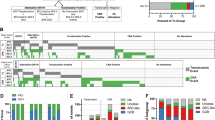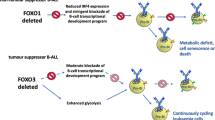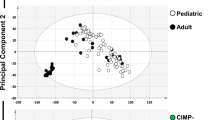Abstract
Deletions in the short arm of chromosome 17 (17p) involving the tumor suppressor TP53 occur in up to 20% of diffuse large B-cell lymphomas (DLBCLs). Although inactivation of both alleles of a tumor suppressor gene is usually required for tumor development, the overlap between TP53 deletions and mutations is poorly understood in DLBCLs, suggesting the possible existence of additional tumor suppressor genes in 17p. Using a bacterial artificial chromosome (BAC) and Phage 1 artificial chromosome (PAC) contig, we here define a minimally deleted region in DLBCLs encompassing approximately 0.8 MB telomeric to the TP53 locus. This genomic region harbors the tumor suppressor Hypermethylated in Cancer 1 (HIC1). Methylation-specific PCR demonstrated hypermethylation of HIC1 exon 1a in a substantial subset of DLBCLs, which is accompanied by simultaneous HIC1 deletion of the second allele in 90% of cases. In contrast, HIC1 inactivation by hypermethylation was rarely encountered in DLBCLs without concomitant loss of the second allele. DLBCL patients with complete inactivation of both HIC1 and TP53 may be characterized by an even inferior clinical course than patients with inactivation of TP53 alone, suggesting a functional cooperation between these two proteins. These findings strongly imply HIC1 as a novel tumor suppressor in a subset of DLBCLs.
This is a preview of subscription content, access via your institution
Access options
Subscribe to this journal
Receive 50 print issues and online access
$259.00 per year
only $5.18 per issue
Buy this article
- Purchase on Springer Link
- Instant access to full article PDF
Prices may be subject to local taxes which are calculated during checkout





Similar content being viewed by others
References
Alizadeh AA, Eisen MB, Davis RE, Ma C, Lossos IS, Rosenwald A et al. (2000). Distinct types of diffuse large B-cell lymphoma identified by gene expression profiling. Nature 403: 503–511.
Bea S, Zettl A, Wright G, Salaverria I, Jehn P, Moreno V et al. (2005). Diffuse large B-cell lymphoma subgroups have distinct genetic profiles that influence tumor biology and improve gene-expression-based survival prediction. Blood 106: 3183–3190.
Britschgi C, Rizzi M, Grob TJ, Tschan MP, Hugli B, Reddy VA et al. (2006). Identification of the p53 family-responsive element in the promoter region of the tumor suppressor gene hypermethylated in cancer 1. Oncogene 25: 2030–2039.
Chen CM, Behringer RR . (2004). Ovca1 regulates cell proliferation, embryonic development, and tumorigenesis. Genes Dev 18: 320–332.
Chen W, Cooper TK, Zahnow CA, Overholtzer M, Zhao Z, Ladanyi M et al. (2004). Epigenetic and genetic loss of Hic1 function accentuates the role of p53 in tumorigenesis. Cancer Cell 6: 387–398.
Chen WY, Wang DH, Yen RC, Luo J, Gu W, Baylin SB . (2005). Tumor suppressor HIC1 directly regulates SIRT1 to modulate p53-dependent DNA-damage responses. Cell 123: 437–448.
Chen WY, Zeng X, Carter MG, Morrell CN, Chiu Yen RW, Esteller M et al. (2003). Heterozygous disruption of Hic1 predisposes mice to a gender-dependent spectrum of malignant tumors. Nat Genet 33: 197–202.
Deltour S, Guerardel C, Leprince D . (1999). Recruitment of SMRT/N-CoR-mSin3A-HDAC-repressing complexes is not a general mechanism for BTB/POZ transcriptional repressors: the case of HIC-1 and gammaFBP-B. Proc Natl Acad Sci USA 96: 14831–14836.
Deltour S, Pinte S, Guerardel C, Wasylyk B, Leprince D . (2002). The human candidate tumor suppressor gene HIC1 recruits CtBP through a degenerate GLDLSKK motif. Mol Cell Biol 22: 4890–4901.
Dong SM, Kim HS, Rha SH, Sidransky D . (2001). Promoter hypermethylation of multiple genes in carcinoma of the uterine cervix. Clin Cancer Res 7: 1982–1986.
Duddy PM, Hanby AM, Barnes DM, Camplejohn RS . (2000). Improving the detection of p53 mutations in breast cancer by use of the FASAY, a functional assay. J Mol Diagn 2: 139–144.
Flaman JM, Frebourg T, Moreau V, Charbonnier F, Martin C, Chappuis P et al. (1995). A simple p53 functional assay for screening cell lines, blood, and tumors. Proc Natl Acad Sci USA 92: 3963–3967.
Goff LK, Neat MJ, Crawley CR, Jones L, Jones E, Lister TA et al. (2000). The use of real-time quantitative polymerase chain reaction and comparative genomic hybridization to identify amplification of the REL gene in follicular lymphoma. Br J Haematol 111: 618–625.
Guerardel C, Deltour S, Pinte S, Monte D, Begue A, Godwin AK et al. (2001). Identification in the human candidate tumor suppressor gene HIC-1 of a new major alternative TATA-less promoter positively regulated by p53. J Biol Chem 276: 3078–3089.
Haralambieva E, Kleiverda K, Mason DY, Schuuring E, Kluin PM . (2002). Detection of three common translocation breakpoints in non-Hodgkin's lymphomas by fluorescence in situ hybridization on routine paraffin-embedded tissue sections. J Pathol 198: 163–170.
Herman JG, Graff JR, Myohanen S, Nelkin BD, Baylin SB . (1996). Methylation-specific PCR: a novel PCR assay for methylation status of CpG islands. Proc Natl Acad Sci USA 93: 9821–9826.
Hida Y, Kubo Y, Murao K, Arase S . (2007). Strong expression of a longevity-related protein, SIRT1, in Bowen's disease. Arch Dermatol Res 299: 103–106.
Huffman DM, Grizzle WE, Bamman MM, Kim JS, Eltoum IA, Elgavish A et al. (2007). SIRT1 is significantly elevated in mouse and human prostate cancer. Cancer Res 67: 6612–6618.
Ichikawa A, Kinoshita T, Watanabe T, Kato H, Nagai H, Tsushita K et al. (1997). Mutations of the p53 gene as a prognostic factor in aggressive B-cell lymphoma. N Engl J Med 337: 529–534.
Ishioka C, Frebourg T, Yan YX, Vidal M, Friend SH, Schmidt S et al. (1993). Screening patients for heterozygous p53 mutations using a functional assay in yeast. Nat Genet 5: 124–129.
Issa JP, Zehnbauer BA, Kaufmann SH, Biel MA, Baylin SB . (1997). HIC1 hypermethylation is a late event in hematopoietic neoplasms. Cancer Res 57: 1678–1681.
Jaffe E, Harris NL, Stein H, Vardiman JW (eds.) (2001). World Health Organization Classification of Tumours: Pathology and Genetics of Tumours of Haematopoietic and Lymphoid Tissues. IARC Press: Lyon.
Kanai Y, Hui AM, Sun L, Ushijima S, Sakamoto M, Tsuda H et al. (1999). DNA hypermethylation at the D17S5 locus and reduced HIC-1 mRNA expression are associated with hepatocarcinogenesis. Hepatology 29: 703–709.
Knudson Jr AG . (1971). Mutation and cancer: statistical study of retinoblastoma. Proc Natl Acad Sci USA 68: 820–823.
Koduru PR, Raju K, Vadmal V, Menezes G, Shah S, Susin M et al. (1997). Correlation between mutation in P53, p53 expression, cytogenetics, histologic type, and survival in patients with B-cell non-Hodgkin's lymphoma. Blood 90: 4078–4091.
Konishi H, Sugiyama M, Mizuno K, Saito H, Yatabe Y, Takahashi T et al. (2003). Detailed characterization of a homozygously deleted region corresponding to a candidate tumor suppressor locus at distal 17p13.3 in human lung cancer. Oncogene 22: 1892–1905.
Leroy K, Haioun C, Lepage E, Le Metayer N, Berger F, Labouyrie E et al. (2002). p53 gene mutations are associated with poor survival in low and low-intermediate risk diffuse large B-cell lymphomas. Ann Oncol 13: 1108–1115.
Lichter P, Bentz M, Joos S . (1995). Detection of chromosomal aberrations by means of molecular cytogenetics: painting of chromosomes and chromosomal subregions and comparative genomic hybridization. Methods Enzymol 254: 334–359.
Lossos IS . (2005). Molecular pathogenesis of diffuse large B-cell lymphoma. J Clin Oncol 23: 6351–6357.
Meinhold-Heerlein I, Ninci E, Ikenberg H, Brandstetter T, Ihling C, Schwenk I et al. (2001). Evaluation of methods to detect p53 mutations in ovarian cancer. Oncology 60: 176–188.
Melki JR, Vincent PC, Clark SJ . (1999). Concurrent DNA hypermethylation of multiple genes in acute myeloid leukemia. Cancer Res 59: 3730–3740.
Nenutil R, Smardova J, Pavlova S, Hanzelkova Z, Muller P, Fabian P et al. (2005). Discriminating functional and non-functional p53 in human tumours by p53 and MDM2 immunohistochemistry. J Pathol 207: 251–259.
Phillips NJ, Ziegler MR, Radford DM, Fair KL, Steinbrueck T, Xynos FP et al. (1996). Allelic deletion on chromosome 17p13.3 in early ovarian cancer. Cancer Res 56: 606–611.
Pinte S, Stankovic-Valentin N, Deltour S, Rood BR, Guerardel C, Leprince D . (2004). The tumor suppressor gene HIC1 (hypermethylated in cancer 1) is a sequence-specific transcriptional repressor: definition of its consensus binding sequence and analysis of its DNA binding and repressive properties. J Biol Chem 279: 38313–38324.
Pinyol M, Hernandez L, Martinez A, Cobo F, Hernandez S, Bea S et al. (2000). INK4a/ARF locus alterations in human non-Hodgkin's lymphomas mainly occur in tumors with wild-type p53 gene. Am J Pathol 156: 1987–1996.
Prowse AH, Vanderveer L, Milling SW, Pan ZZ, Dunbrack RL, Xu XX et al. (2002). OVCA2 is downregulated and degraded during retinoid-induced apoptosis. Int J Cancer 99: 185–192.
Rathi A, Virmani AK, Harada K, Timmons CF, Miyajima K, Hay RJ et al. (2003). Aberrant methylation of the HIC1 promoter is a frequent event in specific pediatric neoplasms. Clin Cancer Res 9: 3674–3678.
Rodgers JT, Lerin C, Haas W, Gygi SP, Spiegelman BM, Puigserver P . (2005). Nutrient control of glucose homeostasis through a complex of PGC-1alpha and SIRT1. Nature 434: 113–118.
Rosenwald A, Wright G, Chan WC, Connors JM, Campo E, Fisher RI et al. (2002). The use of molecular profiling to predict survival after chemotherapy for diffuse large-B-cell lymphoma. N Engl J Med 346: 1937–1947.
Rosenwald A, Wright G, Leroy K, Yu X, Gaulard P, Gascoyne RD et al. (2003a). Molecular diagnosis of primary mediastinal B cell lymphoma identifies a clinically favorable subgroup of diffuse large B cell lymphoma related to Hodgkin lymphoma. J Exp Med 198: 851–862.
Rosenwald A, Wright G, Wiestner A, Chan WC, Connors JM, Campo E et al. (2003b). The proliferation gene expression signature is a quantitative integrator of oncogenic events that predicts survival in mantle cell lymphoma. Cancer Cell 3: 185–197.
Rudiger T, Ott G, Ott MM, Muller-Deubert SM, Muller-Hermelink HK . (1998). Differential diagnosis between classic Hodgkin's lymphoma, T-cell-rich B-cell lymphoma, and paragranuloma by paraffin immunohistochemistry. Am J Surg Pathol 22: 1184–1191.
Sankar M, Tanaka K, Kumaravel TS, Arif M, Shintani T, Yagi S et al. (1998). Identification of a commonly deleted region at 17p13.3 in leukemia and lymphoma associated with 17p abnormality. Leukemia 12: 510–516.
Savage KJ, Monti S, Kutok JL, Cattoretti G, Neuberg D, De Leval L et al. (2003). The molecular signature of mediastinal large B-cell lymphoma differs from that of other diffuse large B-cell lymphomas and shares features with classical Hodgkin lymphoma. Blood 102: 3871–3879.
Saxena A, Clark WC, Robertson JT, Ikejiri B, Oldfield EH, Ali IU . (1992). Evidence for the involvement of a potential second tumor suppressor gene on chromosome 17 distinct from p53 in malignant astrocytomas. Cancer Res 52: 6716–6721.
Schlegelberger B, Zwingers T, Harder L, Nowotny H, Siebert R, Vesely M et al. (1999). Clinicopathogenetic significance of chromosomal abnormalities in patients with blastic peripheral B-cell lymphoma. Kiel-Wien-Lymphoma Study Group. Blood 94: 3114–3120.
Schultz DC, Vanderveer L, Berman DB, Hamilton TC, Wong AJ, Godwin AK . (1996). Identification of two candidate tumor suppressor genes on chromosome 17p13.3. Cancer Res 56: 1997–2002.
Seitz S, Poppe K, Fischer J, Nothnagel A, Estevez-Schwarz L, Haensch W et al. (2001). Detailed deletion mapping in sporadic breast cancer at chromosomal region 17p13 distal to the TP53 gene: association with clinicopathological parameters. J Pathol 194: 318–326.
Shaffer LG, Tommerup N . (2005). An International System for Human Cytogenetic Nomenclature. S Karger AG: Memphis, TN, USA.
Smardova J, Nemajerova A, Trbusek M, Vagunda V, Kovarik J . (2001). Rare somatic p53 mutation identified in breast cancer: a case report. Tumour Biol 22: 59–66.
Stokke T, DeAngelis P, Smedshammer L, Galteland E, Steen HB, Smeland EB et al. (2001). Loss of chromosome 11q21-23.1 and 17p and gain of chromosome 6p are independent prognostic indicators in B-cell non-Hodgkin's lymphoma. Br J Cancer 85: 1900–1913.
Stokke T, Galteland E, Holte H, Smedshammer L, Suo Z, Smeland EB et al. (2000). Oncogenic aberrations in the p53 pathway are associated with a high S phase fraction and poor patient survival in B-cell Non-Hodgkin's lymphoma. Int J Cancer 89: 313–324.
von Bergh A, Emanuel B, van Zelderen-Bhola S, Smetsers T, van Soest R, Stul M et al. (2000). A DNA probe combination for improved detection of MLL/11q23 breakpoints by double-color interphase-FISH in acute leukemias. Genes Chromosomes Cancer 28: 14–22.
Waha A, Koch A, Hartmann W, Mack H, Schramm J, Sorensen N et al. (2004). Analysis of HIC-1 methylation and transcription in human ependymomas. Int J Cancer 110: 542–549.
Wales MM, Biel MA, el Deiry W, Nelkin BD, Issa JP, Cavenee WK et al. (1995). p53 activates expression of HIC-1, a new candidate tumour suppressor gene on 17p13.3. Nat Med 1: 570–577.
Waridel F, Estreicher A, Bron L, Flaman JM, Fontolliet C, Monnier P et al. (1997). Field cancerisation and polyclonal p53 mutation in the upper aero-digestive tract. Oncogene 14: 163–169.
Zettl A, Strobel P, Wagner K, Katzenberger T, Ott G, Rosenwald A et al. (2000). Recurrent genetic aberrations in thymoma and thymic carcinoma. Am J Pathol 157: 257–266.
Zhang Q, Wang SY, Fleuriel C, Leprince D, Rocheleau JV, Piston DW et al. (2007). Metabolic regulation of SIRT1 transcription via a HIC1:CtBP corepressor complex. Proc Natl Acad Sci USA 104: 829–833.
Acknowledgements
We thank Heike Brueckner, Irina Eichelbroenner, Doris Hetzer and Petra Stempfle for their excellent technical assistance. H S is a member of the Graduiertenkolleg 639 (Tumorinstabilität) which is supported by the Deutsche Forschungsgesellschaft (DFG). AR is supported by the Interdisciplinary Center for Clinical Research (IZKF), University of Würzburg.
Author information
Authors and Affiliations
Corresponding author
Rights and permissions
About this article
Cite this article
Stöcklein, H., Smardova, J., Macak, J. et al. Detailed mapping of chromosome 17p deletions reveals HIC1 as a novel tumor suppressor gene candidate telomeric to TP53 in diffuse large B-cell lymphoma. Oncogene 27, 2613–2625 (2008). https://doi.org/10.1038/sj.onc.1210901
Received:
Revised:
Accepted:
Published:
Issue Date:
DOI: https://doi.org/10.1038/sj.onc.1210901
Keywords
This article is cited by
-
Tumor suppressor HIC1 is synergistically compromised by cancer-associated fibroblasts and tumor cells through the IL-6/pSTAT3 axis in breast cancer
BMC Cancer (2019)
-
Clinical aspects of TP53 gene inactivation in diffuse large B-cell lymphoma
BMC Medical Genomics (2019)
-
Catalog of genetic progression of human cancers: non-Hodgkin lymphoma
Cancer and Metastasis Reviews (2016)
-
Signification of Hypermethylated in Cancer 1 (HIC1) as Tumor Suppressor Gene in Tumor Progression
Cancer Microenvironment (2012)
-
Role of E-cadherin gene in gall bladder cancer and its precursor lesions
Virchows Archiv (2010)



